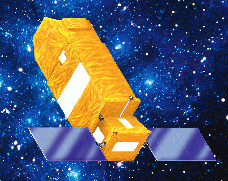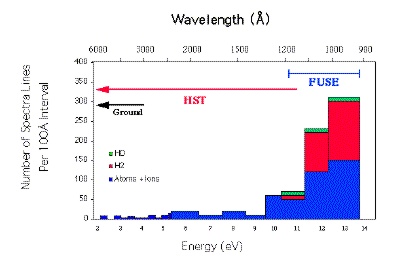Principal scientific aims for FUSE
 The FUSE wavelength region is hitherto largely unexplored. In the 1970s, the
Copernicus mission opened the far-UV universe by obtaining spectra of bright,
nearby hot stars (within 3000 light years of the Sun).
Two telescopes, HUT and ORFEUS, flown on Shuttle missions, have also
provided brief but tantalizing glimpses into the far-UV.
FUSE will be able to observe sources more than 10,000
times fainter than Copernicus, reaching faint, distant objects in
our Galaxy and beyond.
The FUSE wavelength region is hitherto largely unexplored. In the 1970s, the
Copernicus mission opened the far-UV universe by obtaining spectra of bright,
nearby hot stars (within 3000 light years of the Sun).
Two telescopes, HUT and ORFEUS, flown on Shuttle missions, have also
provided brief but tantalizing glimpses into the far-UV.
FUSE will be able to observe sources more than 10,000
times fainter than Copernicus, reaching faint, distant objects in
our Galaxy and beyond.

The spectral window opened by FUSE will permit the study of many
important atoms, ions, and molecules that cannot be investigated otherwise.
The
wavelength range that FUSE will explore, is extremely rich in
spectral lines arising within the interstellar gas, the material from which
stars and planets form. The far-UV range also provides an opportunity to answer
important questions about many types of astrophysical objects, such as
the nuclear regions of active galaxies and quasars, massive stars,
supernovae, planetary nebulae, and the outer atmospheres of
cool stars and planets.

 The FUSE wavelength region is hitherto largely unexplored. In the 1970s, the
Copernicus mission opened the far-UV universe by obtaining spectra of bright,
nearby hot stars (within 3000 light years of the Sun).
Two telescopes, HUT and ORFEUS, flown on Shuttle missions, have also
provided brief but tantalizing glimpses into the far-UV.
FUSE will be able to observe sources more than 10,000
times fainter than Copernicus, reaching faint, distant objects in
our Galaxy and beyond.
The FUSE wavelength region is hitherto largely unexplored. In the 1970s, the
Copernicus mission opened the far-UV universe by obtaining spectra of bright,
nearby hot stars (within 3000 light years of the Sun).
Two telescopes, HUT and ORFEUS, flown on Shuttle missions, have also
provided brief but tantalizing glimpses into the far-UV.
FUSE will be able to observe sources more than 10,000
times fainter than Copernicus, reaching faint, distant objects in
our Galaxy and beyond.
